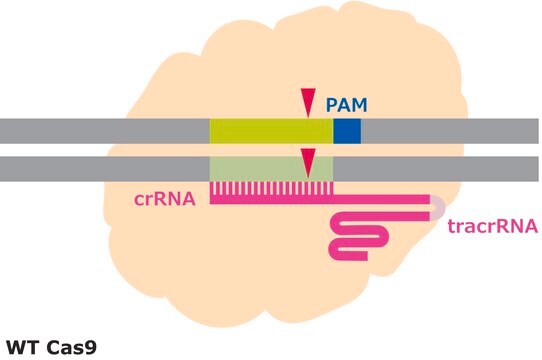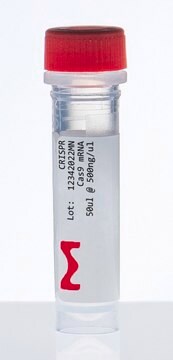CAS9PL
Cas9 Plus Protein
from Streptococcus pyogenes, recombinant, expressed in E. coli, 3X NLS
Synonym(s):
Cas9, SpCas9, SpyCas9
About This Item
Recommended Products
recombinant
expressed in E. coli
Quality Level
Assay
≥95% (SDS-PAGE)
form
lyophilized powder
packaging
pkg of 1 kit (4 components)
application(s)
CRISPR
shipped in
wet ice
storage temp.
−20°C
General description
Application
Features and Benefits
- Enhanced specificity compared to wild type Cas9
- Increased activity compared to enhanced specificity Cas9
- Ready to inject/transfect
Packaging
pkg of 250 μg (≥ 1500 pmol)
Components
- one vial of Cas9 Plus Recombinant Protein
- one vial of Plus Transfection Buffer
- one vial of Reconstitution Buffer
- one vial of Dilution Buffer
Principle
Reconstitution
Other Notes
Check out our other MISSION® Cas9 Proteins at SigmaAldrich.com/CRISPRproteins
Legal Information
Storage Class Code
10 - Combustible liquids
Regulatory Listings
Regulatory Listings are mainly provided for chemical products. Only limited information can be provided here for non-chemical products. No entry means none of the components are listed. It is the user’s obligation to ensure the safe and legal use of the product.
PDSCL
Please refer to KIT Component information
PRTR
Please refer to KIT Component information
FSL
Please refer to KIT Component information
ISHL Indicated Name
Please refer to KIT Component information
ISHL Notified Names
Please refer to KIT Component information
Cartagena Act
Please refer to KIT Component information
JAN Code
キットコンポーネントの情報を参照してください
Certificates of Analysis (COA)
Search for Certificates of Analysis (COA) by entering the products Lot/Batch Number. Lot and Batch Numbers can be found on a product’s label following the words ‘Lot’ or ‘Batch’.
Already Own This Product?
Find documentation for the products that you have recently purchased in the Document Library.
Our team of scientists has experience in all areas of research including Life Science, Material Science, Chemical Synthesis, Chromatography, Analytical and many others.
Contact Technical Service








